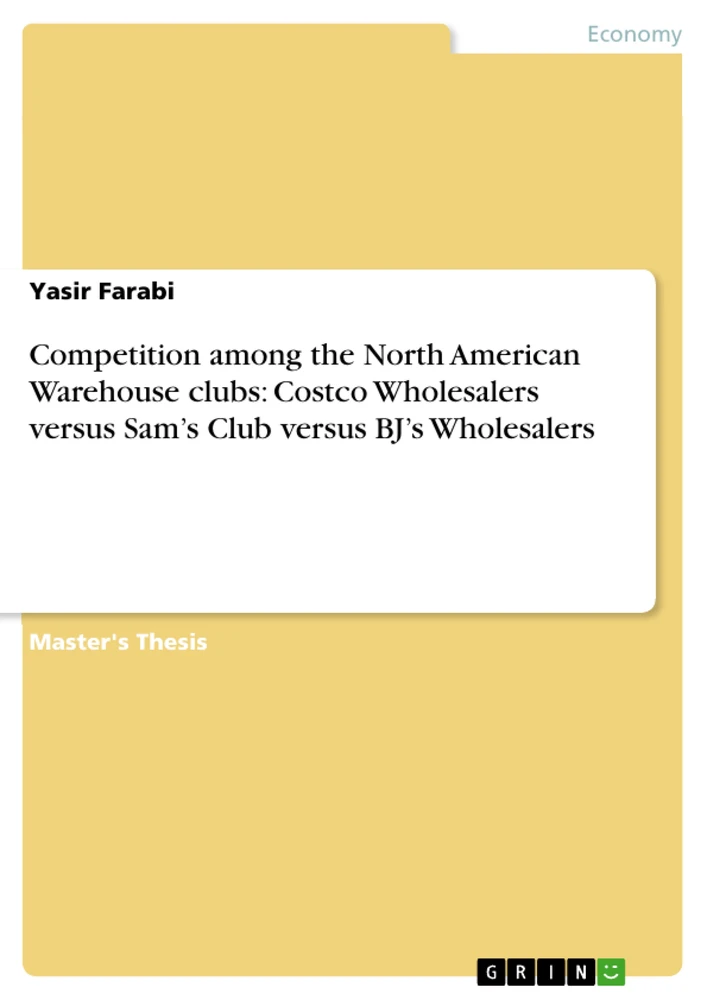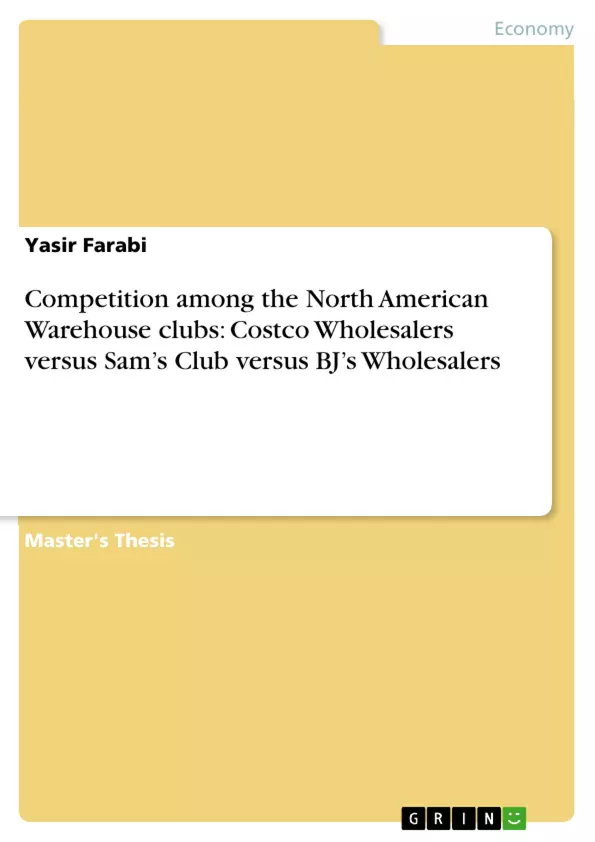
Competition among the North American Warehouse clubs: Costco Wholesalers versus Sam’s Club versus BJ’s Wholesalers
Masterarbeit, 2012
20 Seiten
Leseprobe
Table of Contents
- Executive Summary
- 1. Introduction
- 1.1 Company Background
- 1.2 Mission Statement
- 1.3 Financial Review
- 1.4 Purpose
- 2. External Environment
- 2.1 Industry's Dominant Economic Features
- 2.2 Competitive forces and the strength of each force
- 2.3 Cause of competitive structure and business environment to change
- 2.4 Rivals' market positions
- 2.5 Strategic moves rivals are likely to make
- 2.6 Key factors for competitive success
- 2.7 Attractiveness of industry and prospect for profitability
- 3. Resource and Competitive Position of Costco
- 3.1 Effectiveness of present strategy
- 3.2 SWOT analysis
- 3.3 Price and cost competitiveness
- 3.4 Strength of company's competitive position
- 3.5 Strategic issues faced by the company
- 4. Generic Strategy Costco uses to achieve competitive advantage
- 5. New Strategy to Ensure Sustainable Competitive Advantage
- 5.1 Cutting cost through efficiency
- 5.2 Shopper Insights
- 5.3 Innovation
- 5.4 Speed
- 5.5 Triple Bottom Line Accounting
- 5.6 Managing Complexity
Objectives and Key Themes
The report aims to comprehensively analyze Costco Wholesale Corporation, evaluating its external environment, competitive standing, and strategic approach. It seeks to identify Costco's competitive advantage and propose a five-year strategic plan for sustained success.
- Costco's competitive strategy within the warehouse club industry.
- Analysis of Costco's strengths and weaknesses in relation to its competitors.
- Evaluation of the external factors impacting Costco's performance.
- Identification of key opportunities for future growth and profitability.
- Development of a sustainable competitive advantage strategy for Costco.
Chapter Summaries
1. Introduction: This chapter provides background information on Costco Wholesale Corporation, including its business model, mission statement, and recent financial performance. It highlights Costco's position as the largest and most profitable warehouse club chain, emphasizing its low-price strategy and commitment to member satisfaction. The chapter also lays out the report's purpose: to analyze Costco's competitive environment, its strategic position, and to propose a new five-year strategy.
2. External Environment: This chapter employs Porter's Five Forces model to analyze the competitive landscape of the warehouse club industry. It examines the threats from new entrants, supplier and buyer power, existing rivalry, and substitute products. The analysis highlights the moderate rivalry among competitors like Sam's Club and BJ's Wholesale, but also notes the challenges posed by changing demographics and evolving consumer preferences. The chapter further investigates the market positions of Costco's rivals, anticipating their strategic moves and identifying key factors for success within the industry.
3. Resource and Competitive Position of Costco: This section delves into Costco's internal resources and competitive standing. It assesses the effectiveness of its current strategy, performing a SWOT analysis to identify its strengths (low prices, loyal customer base, high inventory turnover) and weaknesses (less attractive store décor, inconsistent profit margins, limited product selection). The chapter also examines Costco's price and cost competitiveness, evaluating its overall competitive strength and pinpointing strategic challenges it faces.
4. Generic Strategy Costco uses to achieve competitive advantage: This chapter focuses on identifying the generic competitive strategy employed by Costco. It concludes that Costco operates as a best-cost provider, combining low prices with a curated selection of products and a "treasure hunt" merchandising approach. This section likely details how this strategy differentiates Costco from its competitors and contributes to its success.
5. New Strategy to Ensure Sustainable Competitive Advantage: This chapter outlines a new five-year strategic plan for Costco. It proposes various initiatives, including cost reduction through operational excellence and innovation, improving speed and efficiency, adopting triple-bottom-line accounting, and developing strategies for managing the complexities of its operating environment. The emphasis is on strategies to sustain Costco's competitive advantage in a dynamic marketplace.
Keywords
Costco Wholesale Corporation, warehouse club industry, competitive advantage, Porter's Five Forces, SWOT analysis, best-cost provider strategy, low-price strategy, sustainable competitive advantage, operational efficiency, innovation, triple bottom line accounting, market share, rivalry, consumer behavior, financial performance.
Costco Wholesale Corporation: A Comprehensive Strategic Analysis - FAQ
What is the overall purpose of this report?
This report aims to comprehensively analyze Costco Wholesale Corporation, evaluating its external environment, competitive standing, and strategic approach. It seeks to identify Costco's competitive advantage and propose a five-year strategic plan for sustained success.
What key themes are explored in this analysis of Costco?
The report explores Costco's competitive strategy within the warehouse club industry, analyzes its strengths and weaknesses against competitors, evaluates external factors impacting its performance, identifies opportunities for future growth and profitability, and develops a sustainable competitive advantage strategy.
What is covered in the Introduction chapter?
The introduction provides background information on Costco, including its business model, mission statement, and recent financial performance. It establishes Costco's position in the market and outlines the report's purpose: to analyze Costco's competitive environment and strategic position, proposing a new five-year strategy.
How does the report analyze Costco's external environment?
The report uses Porter's Five Forces model to analyze the competitive landscape of the warehouse club industry. It examines threats from new entrants, supplier and buyer power, existing rivalry (including competitors like Sam's Club and BJ's Wholesale), and substitute products. It also considers changing demographics and consumer preferences and anticipates rivals' strategic moves.
What internal aspects of Costco are examined in the report?
The report delves into Costco's internal resources and competitive standing. It assesses the effectiveness of its current strategy through a SWOT analysis, identifying strengths (low prices, loyal customer base, high inventory turnover) and weaknesses (store décor, profit margins, product selection). It also examines price and cost competitiveness and pinpoints strategic challenges.
What is Costco's generic competitive strategy, according to this report?
The report identifies Costco's generic competitive strategy as a best-cost provider, combining low prices with a curated product selection and a "treasure hunt" merchandising approach. This strategy differentiates Costco from its competitors.
What is proposed in the new five-year strategic plan for Costco?
The five-year strategic plan proposes initiatives including cost reduction through operational excellence and innovation, improving speed and efficiency, adopting triple-bottom-line accounting, and strategies for managing operational complexities. The focus is on sustaining Costco's competitive advantage.
What are some of the key keywords associated with this analysis?
Key keywords include Costco Wholesale Corporation, warehouse club industry, competitive advantage, Porter's Five Forces, SWOT analysis, best-cost provider strategy, low-price strategy, sustainable competitive advantage, operational efficiency, innovation, triple bottom line accounting, market share, rivalry, consumer behavior, and financial performance.
What specific tools or frameworks are used in this analysis?
The analysis utilizes Porter's Five Forces model to assess the competitive landscape and SWOT analysis to evaluate Costco's internal strengths and weaknesses. The concept of a "best-cost provider" strategy is also central to the analysis.
What is the overall conclusion regarding Costco's future?
The report concludes by proposing a new five-year strategic plan designed to ensure Costco's sustainable competitive advantage in a dynamic marketplace. This plan focuses on enhancing operational efficiency, driving innovation, and adapting to evolving consumer preferences and market conditions.
Details
- Titel
- Competition among the North American Warehouse clubs: Costco Wholesalers versus Sam’s Club versus BJ’s Wholesalers
- Hochschule
- University of New England
- Veranstaltung
- Strategic Management
- Autor
- Yasir Farabi (Autor:in)
- Erscheinungsjahr
- 2012
- Seiten
- 20
- Katalognummer
- V197075
- ISBN (eBook)
- 9783656231318
- ISBN (Buch)
- 9783656231875
- Dateigröße
- 732 KB
- Sprache
- Englisch
- Schlagworte
- competition north american warehouse costco wholesalers sam’s club bj’s
- Produktsicherheit
- GRIN Publishing GmbH
- Preis (Ebook)
- US$ 17,99
- Preis (Book)
- US$ 20,99
- Arbeit zitieren
- Yasir Farabi (Autor:in), 2012, Competition among the North American Warehouse clubs: Costco Wholesalers versus Sam’s Club versus BJ’s Wholesalers, München, Page::Imprint:: GRINVerlagOHG, https://www.diplomarbeiten24.de/document/197075
- Autor werden
- Ihre Optionen
- Vertriebskanäle
- Premium Services
- Autorenprofil
- Textarten und Formate
- Services für Verlage, Hochschulen, Unternehmen

- © GRIN Publishing GmbH.
- Alle Inhalte urheberrechtlich geschützt. Kopieren und verbreiten untersagt.
- info@grin.com
- AGB
- Open Publishing
Der GRIN Verlag hat sich seit 1998 auf die Veröffentlichung akademischer eBooks und Bücher spezialisiert. Der GRIN Verlag steht damit als erstes Unternehmen für User Generated Quality Content. Die Verlagsseiten GRIN.com, Hausarbeiten.de und Diplomarbeiten24 bieten für Hochschullehrer, Absolventen und Studenten die ideale Plattform, wissenschaftliche Texte wie Hausarbeiten, Referate, Bachelorarbeiten, Masterarbeiten, Diplomarbeiten, Dissertationen und wissenschaftliche Aufsätze einem breiten Publikum zu präsentieren.
Kostenfreie Veröffentlichung: Hausarbeit, Bachelorarbeit, Diplomarbeit, Dissertation, Masterarbeit, Interpretation oder Referat jetzt veröffentlichen!
- GRIN Verlag GmbH
-
- Nymphenburger Str. 86
- 80636
- Munich, Deutschland
- +49 89-550559-0
- +49 89-550559-10
- info@grin.com
-









